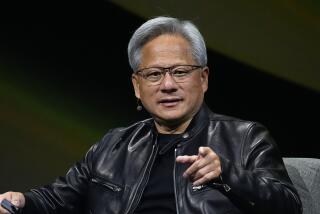Wise Choices, Luck Keep U.S. the High-Tech Leader
- Share via
As 1993 draws to a close, with America’s high-tech industries in the catbird seat of competitiveness, do I detect just a hint of smugness?
“I cannot think of a single major area in technology where the U.S. did not gain ground in the 1980s,” former Reagan science adviser George A. Keyworth insisted in a recent Hudson Institute briefing paper. “And in what are clearly the two most important areas (or at least most focused-on ones)--digital technologies, meaning computing and telecommunications, and biotechnology--the United States not only did well in the ‘80s but significantly increased its lead over the rest of the world.”
From the vantage of the ‘90s, there’s more truth to that assertion than the Chicken Littles of competitiveness might care to admit. Then again, consider the current state of the competition: Just like its economy, Japan’s keiretsu (conglomerates) remain exhausted, depressed and confused. The European Community’s grand, state-funded innovation schemes have shriveled into desperate wish lists. India, China and the Little Dragons are technologically accelerating, but they still lag years behind.
So for the first time in two difficult decades, America enters a new year as the undisputed global leader in virtually every high-technology area that matters.
Yes, but will it last? As former IBM Chairman John Akers would be the first to acknowledge, leadership in high-technology industries can be extraordinarily fragile. Technological preeminence today is often as much the happy conspiracy of circumstance as the result of brilliant innovations brilliantly managed.
And for all its brilliance, American high-tech today is a happy victim of circumstance.
Consider multimedia, which was grotesquely over-hyped this year. For every clever step taken by American enterprise, superbly positioned Japanese firms like Sony, Matsushita and Nintendo have awkwardly stumbled. Where American companies understood the rising importance of digital video, the Sonys and Matsushitas invested billions of yen trying to flog analog video to another level. The market didn’t respond.
Similarly, Sony’s efforts to create a portable multimedia counterpart to its successful Walkman--the Bookman--proved a poorly designed package of potentially interesting technologies. Nintendo--once the overwhelmingly dominant force in the multibillion-dollar global video games market--was late bringing popular CD-ROM technology to its players and missed a clear billion-dollar opportunity in telecommunications by not trying to create an on-line video game network in America.
With few notable exceptions, Japanese thrusts into the personal and portable computer markets have excited no one.
From the microprocessors fabricated by Intel to the operating systems written by Microsoft to the multimedia design tools crafted by Macromedia to the CD-ROMs pressed by Voyager, the global multimedia agenda is being defined by American companies. They are setting the standards.
Now, it’s not that Japanese consumer electronics companies have suddenly lost their technological prowess, their ability to invest in innovation or their wits. It’s not even that they can’t write software. Their problem is that it is now their turn to be the victims of their own success.
The patterns of technological innovation that enabled them to capture market share so dramatically in the 1980s have changed. The new market opportunities are no longer compatible with their traditional design sensibilities.
As American companies, from General Instrument to Hughes to AT&T;, cut deals to consolidate their positions in these emerging telecommunications media, this is the year Japanese companies have to decide how they want to play in the game. Who do they want to learn from? Who do they want to partner with? How do they better integrate the incredible resources they already possess?
Most important, how are they going to fundamentally change the culture of innovation that once worked so well for them? Thanks to the Japanese, these are all painful questions that American companies have had to struggle with for more than a decade. Now that their economic bubble has burst and their first generation of 1990s innovations have proven unspectacular, it is the Japanese who are having to come up with the painful answers. They haven’t yet.
Of course, government has a critical role in all of this. It certainly didn’t help Japan’s digital designs in the 1980s that the influential Ministry of International Trade and Industry made IBM and Cray supercomputers the benchmark paradigm for computational competitiveness.
Similarly, the fact that Germany’s biotech regulations are so stringent that they have, in effect, throttled innovation in a field where the country’s chemical industry has a tradition of success helps explain why Europe’s efforts to catch up with the U.S. biotech industry will not be realized in this decade.
Of course, the terrific irony for a Reaganaut like George Keyworth must be that America’s preeminence in computation, telecommunications and biotech is a direct result of active government intervention.
Was there any more effective example of high-tech “industrial policy” than the antitrust action that broke up the Bell system and laid the groundwork for today’s “information highway”? How about the Federal Communications Commission ruling requiring a shift from analog to digital television? Could the biotech industry even think of existing without the enormous research and human capital infrastructure of the National Institutes of Health?
As America enters 1994 as the world’s leading technological superpower, the policy debate is going to shift subtly from what policies best enable us to regain high-tech competitiveness to what policies will let us best preserve it. Japan, Europe and the rest of the world will be monitoring that one with interest.
Michael Schrage is a writer, consultant and research associate at the Massachusetts Institute of Technology. He writes this column independently for The Times. He can be reached by electronic mail at [email protected] on the Internet.






